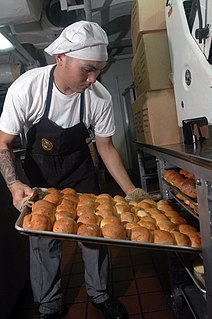
A baker is a tradesperson who bakes and sometimes sells breads and other products made of flour by using an oven or other concentrated heat source. The place where a baker works is called a bakery.

A biscuit is a flour-based baked food product. In most countries—particularly in the Commonwealth and Ireland—biscuits are typically hard, flat and unleavened. They are usually sweet and may be made with sugar, chocolate, icing, jam, ginger or cinnamon. They can also be savoury and similar to crackers. Types of biscuit include sandwich biscuits, digestive biscuits, ginger biscuits, shortbread biscuits, chocolate chip cookies, chocolate-coated marshmallow treats, Anzac biscuits, biscotti and speculaas. In most of North America, nearly all hard sweet biscuits are called "cookies", while the term "biscuit" refers to a soft, leavened quick bread similar to a scone, for which see biscuit (bread).
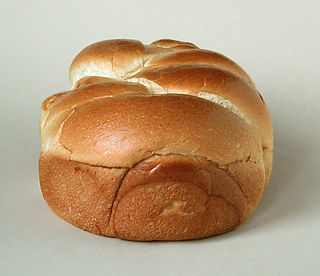
Brioche is a bread of French origin and whose high egg and butter content gives it a rich and tender crumb. Chef Joël Robuchon described it as "light and slightly puffy, more or less fine, according to the proportion of butter and eggs." It has a dark, golden, and flaky crust, frequently accentuated by an egg wash applied after proofing.
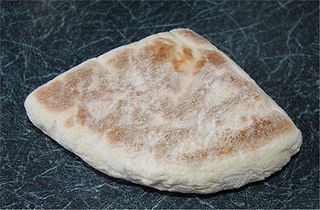
Soda bread is a variety of quick bread traditionally made in a variety of cuisines in which sodium bicarbonate is used as a leavening agent instead of the traditional yeast. The ingredients of traditional soda bread are flour, baking soda, salt, and buttermilk. The buttermilk in the dough contains lactic acid, which reacts with the baking soda to form tiny bubbles of carbon dioxide. Other ingredients can be added, such as butter, egg, raisins, or nuts. An advantage of quick breads is their ability to be prepared quickly and reliably, without requiring the time-consuming skilled labor and temperature control needed for traditional yeast breads.

Elizabeth David, CBE was a British cookery writer. In the mid-20th century she strongly influenced the revitalisation of home cookery in her native country and beyond with articles and books about European cuisines and traditional British dishes.

Jane Grigson was an English cookery writer. In the latter part of the 20th century she was the author of the food column for The Observer and wrote numerous books about European cuisines and traditional British dishes. Her work proved influential in promoting British food.

Eliza Acton was an English food writer and poet who produced one of Britain's first cookery books aimed at the domestic reader, Modern Cookery for Private Families. The book introduced the now-universal practice of listing ingredients and giving suggested cooking times for each recipe. It included the first recipes in English for Brussels sprouts and for spaghetti. It also contains the first recipe for what Acton called "Christmas pudding"; the dish was normally called plum pudding, recipes for which had appeared previously, although Acton was the first to put the name and recipe together.

Hannah Glasse was an English cookery writer of the 18th century. Her first cookery book, The Art of Cookery Made Plain and Easy, published in 1747, became the best-selling recipe book that century. It was reprinted within its first year of publication, appeared in 20 editions in the 18th century, and continued to be published until well into the 19th century. She later wrote The Servants' Directory (1760) and The Compleat Confectioner, which was probably published in 1760; neither book was as commercially successful as her first.

The Bath bun is a sweet roll made from a milk-based yeast dough with crushed sugar sprinkled on top after baking. Variations in ingredients include enclosing a lump of sugar in the bun or adding candied fruit peel, currants, raisins or sultanas.

Pain de campagne, also called "French sourdough", is typically a large round loaf ("miche") made from either natural leavening or baker's yeast. Most traditional versions of this bread are made with a combination of white flour with whole wheat flour and/or rye flour, water, leavening and salt. For centuries, French villages had communal ovens where the townsfolk would bring their dough to be baked, and the loaves weighed from four to as much as twelve pounds (1.5–5.5 kg). Such large loaves would feed a family for days or weeks, until the next baking day.

Lardy cake, also known as lardy bread, lardy Johns, dough cake and fourses cake is a traditional rich spiced form of bread found in several southern counties of England, each claiming to provide the original recipe. It remains a popular weekend tea cake in the southern counties of England, including Sussex, Hampshire, Berkshire, Wiltshire, Dorset and Gloucestershire.

A cottage loaf is a traditional type of bread originating in England.

In the United States and Canada, a biscuit is any of a variety of small baked goods with a firm browned crust and a soft, crumbly interior. They are usually made with baking powder or baking soda as a chemical leavening agent rather than yeast. They developed from hardtack which was first made from only flour and water, with later first lard and then baking powder being added. Biscuits, soda breads, and cornbread, among others, are often referred to collectively as "quick breads", to indicate that they do not need time to rise before baking.

Elizabeth Raffald was an English author, innovator and entrepreneur.
Elizabeth David, the British cookery writer, published eight books in the 34 years between 1950 and 1984; the last was issued eight years before her death. After David's death, her literary executor, Jill Norman, supervised the publication of eight more books, drawing on David's unpublished manuscripts and research and on her published writings for books and magazines.
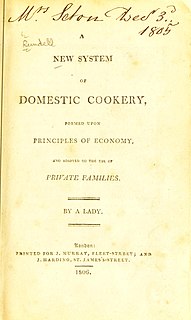
Maria Eliza Rundell was an English writer. Little is known about most of her life, but in 1805, when she was over 60, she sent an unedited collection of recipes and household advice to John Murray, of whose family—owners of the John Murray publishing house—she was a friend. She asked for, and expected, no payment or royalties.

Modern Cookery for Private Families is an English cookery book by Eliza Acton. It was first published by Longmans in 1845, and was a best-seller, running through 13 editions by 1853, though its sales were later overtaken by Mrs Beeton. On the strength of the book, Delia Smith called Acton "the best writer of recipes in the English language", while Elizabeth David wondered why "this peerless writer" had been eclipsed by such inferior and inexperienced imitators.
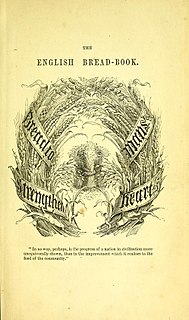
The English Bread Book is an English cookery book by Eliza Acton, first published in 1857. The work consists of a history of bread making in England, improvements to the process developed in Europe, an examination of the ingredients used and recipes of different types of bread.
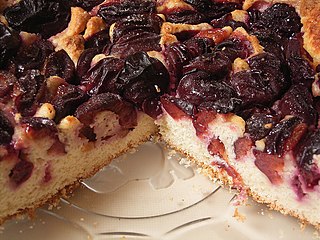
Plum cake refers to a wide range of cakes made with either dried fruit or with fresh fruit. There is a wide range of popular plum cakes and puddings. Since the meaning of the word "plum" has changed over time, many items referred to as plum cakes and popular in England since at least the eighteenth century have now become known as fruitcake. The English variety of plum cake also exists on the European mainland, but may vary in ingredients and consistency. Settlers in British colonies brought the dried fruit variety of cake with them, so that for example, in India it was served around the time of the Christmas holiday season and in the American colonies, where it became associated with elections, one version came to be called "election cake".
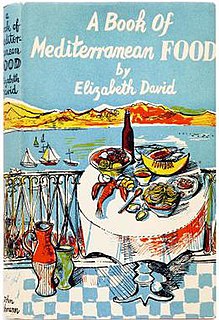
A Book of Mediterranean Food was an influential cookery book written by Elizabeth David in 1950, her first, and published by John Lehmann. After years of rationing and wartime austerity, the book brought light and colour back to English cooking, with simple fresh ingredients, from David's experience of Mediterranean cooking while living in France, Italy and Greece. The book was illustrated by John Minton, and the chapters were introduced with quotations from famous writers.






















